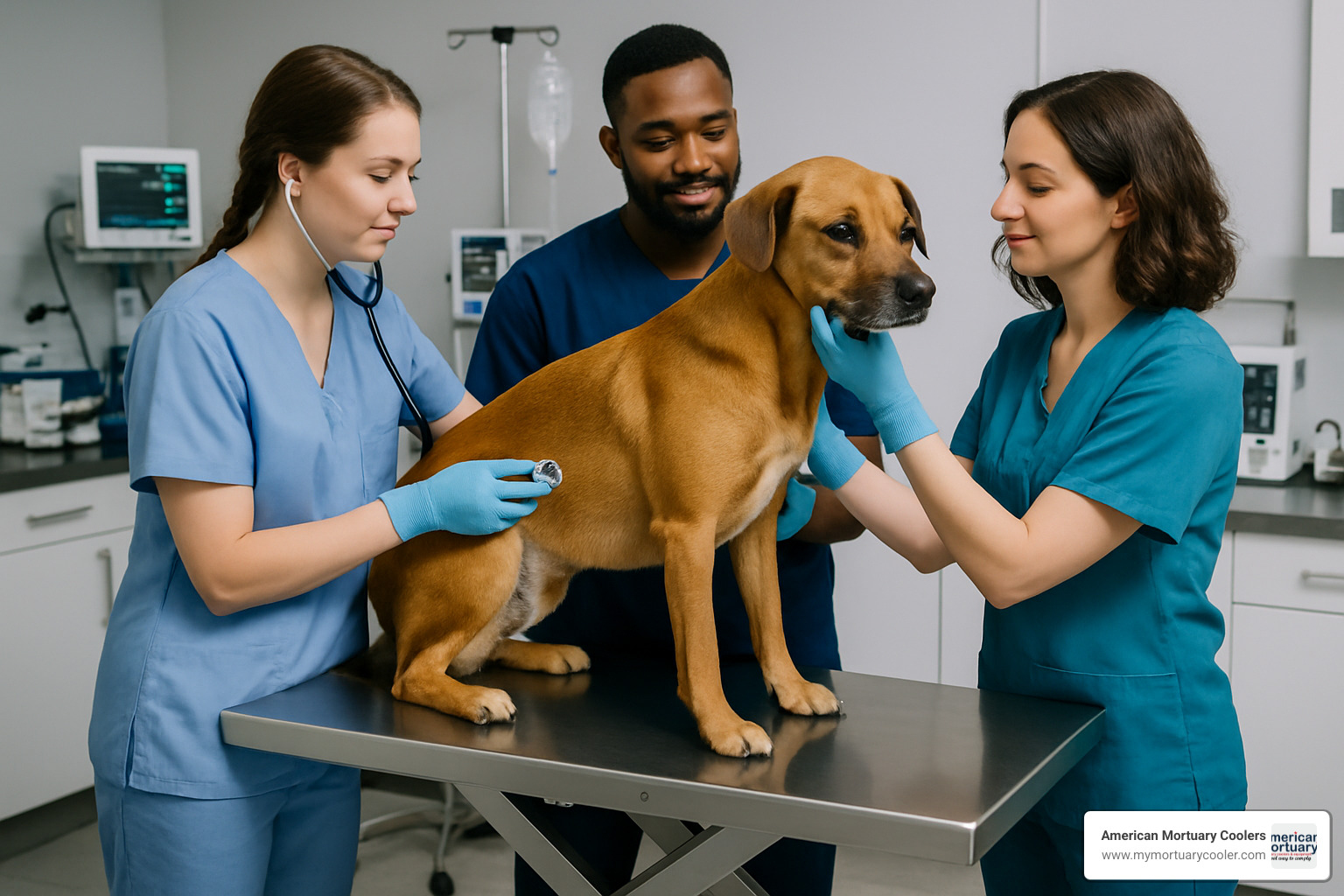
Beginner's Guide to Comparing Vet Exam Tables
Selecting the Right Veterinary Exam Table for Your Practice
A vet exam table is a specialized piece of equipment designed to support animals during examinations and procedures in veterinary clinics and hospitals. When choosing the right table for your practice, consider these essential factors:
| Feature | Options | Why It Matters |
|---|---|---|
| Type | Stationary, Electric Lift, Hydraulic, Wall-mounted, Folding | Affects workflow, space utilization, and staff ergonomics |
| Material | Stainless Steel (most common), Laminate, Phenolic | Impacts durability, cleaning ease, and infection control |
| Height Range | 20"-47" (adjustable tables) | Reduces staff strain and improves patient positioning |
| Weight Capacity | 220-573 lbs | Must accommodate your largest patients safely |
| Special Features | Scale integration, Tie-downs, Storage, Tilt function | Improves functionality for your specific procedures |
The vet exam table serves as the central hub of any veterinary practice, where diagnoses are made, treatments are performed, and critical patient care takes place. Selecting the appropriate table isn't just about finding a surface to place animals on—it's about investing in a tool that will support your clinical workflow, protect your staff from injury, and create a comfortable experience for your patients.
Height-adjustable models have become increasingly popular as awareness of staff ergonomics grows. Studies show these tables can significantly reduce the risk of musculoskeletal injuries among veterinary professionals who might otherwise spend hours bent over at uncomfortable angles.
I'm Mortuary Cooler, and I've spent over a decade helping healthcare facilities select appropriate equipment including vet exam tables that prioritize functionality, durability and staff safety. My experience with stainless steel construction in both mortuary and veterinary settings has given me unique insight into selecting tables that maintain hygienic standards while providing excellent value.
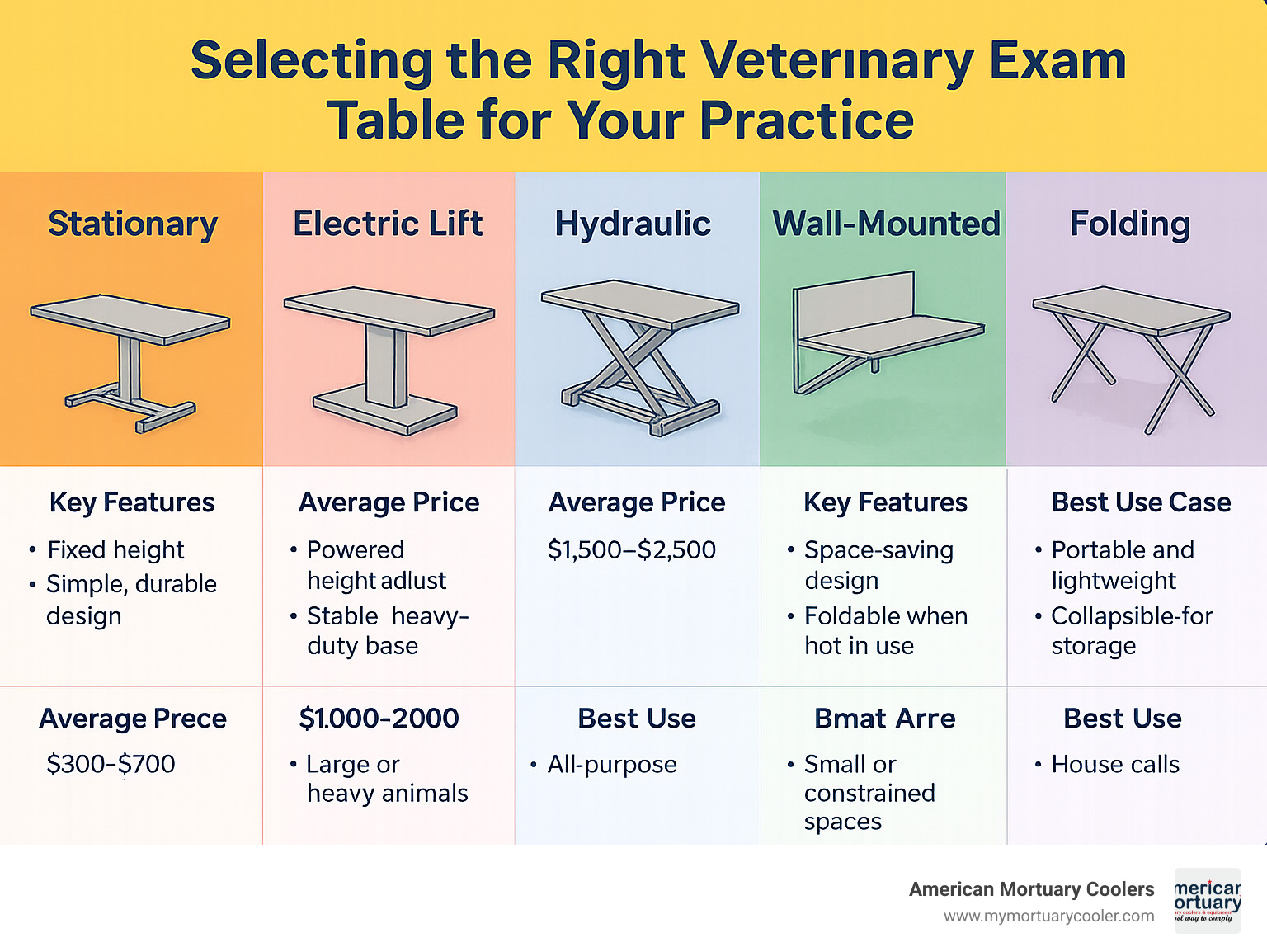
Handy vet exam table terms:
What Is a Vet Exam Table?
A vet exam table is the heart of any veterinary practice – a specially designed platform where the magic of animal medicine happens daily. Unlike your kitchen counter or a human medical table, these workhorses are built specifically for four-legged (or sometimes winged or scaled) patients with all their unique needs in mind.
Think of your vet exam table as mission control for patient care. It's where puppies get their first vaccines, senior cats receive thorough check-ups, and countless medical mysteries are solved through careful examination.
"Your exam table is the workhorse of any practice," explains Dr. Sarah Thompson, who's been treating animals for 15 years. "It's where 90% of your patient interactions happen, from routine check-ups to minor procedures. Having the right table can make or break your clinical efficiency."
These tables are built tough to handle everything your animal patients might throw at them (sometimes literally!). They withstand anxious scratching and chewing, frequent cleaning with powerful disinfectants, various bodily fluids, and patients of all sizes and temperaments.
When it comes to weight capacity, most vet exam tables can support between 220 pounds for small animal practices and a whopping 573 pounds for facilities that treat larger animals. This ensures you can safely examine everything from hamsters to Great Danes without worry.
Primary Purpose of a Vet Exam Table
Your vet exam table does far more than just lift animals off the floor. These specialized surfaces serve as the foundation for quality veterinary care in several important ways:
First, they provide the perfect diagnostic foundation where veterinarians can perform thorough examinations. That stable surface makes it possible to detect subtle abnormalities when listening to a heart or feeling for masses that might otherwise be missed.
They also enable optimal positioning for various procedures. Whether drawing blood from a wiggly puppy or getting the perfect angle for x-rays, proper positioning is crucial for accuracy and safety.
Many veterinarians also use their exam table as a client communication hub. It's where they can demonstrate findings and discuss treatment plans with concerned pet parents who need to understand what's happening with their furry family members.
Perhaps most importantly, a good vet exam table balances patient comfort with necessary control. As Dr. James Wilson, veterinary practice consultant, puts it: "A quality exam table should allow you to focus entirely on your patient rather than wrestling with equipment limitations. The best tables become almost invisible in your workflow because they so perfectly support what you need to do."
Typical Dimensions & Weight Capacities of Vet Exam Tables
Shopping for a vet exam table means getting familiar with standard measurements that will work for your space and patient population.
Most veterinary exam tables come in dimensions around 48" x 24" or 60" x 22" for length and width. Height is where things get interesting – adjustable tables typically offer ranges from as low as 20" all the way up to 47" high, allowing for perfect positioning regardless of the procedure or staff member's height.
Dr. Michael Chen from Pawprint Veterinary Hospital offers this practical advice: "We opted for a table with a 500 lb capacity even though our average patient is under 70 lbs. That extra capacity gives us peace of mind for larger breeds and ensures the table's longevity under daily use."
The height adjustment feature isn't just about convenience – it's about protecting your team's health. Many veterinary professionals develop back and neck problems from years of bending over fixed-height tables. Height-adjustable models allow staff members of different heights to work comfortably while reducing their risk of painful repetitive strain injuries.
How Veterinary Exam Tables Differ from Human Medical Tables
While they might look somewhat similar at first glance, vet exam tables have evolved with special features that set them apart from their human-focused counterparts.
Most noticeably, veterinary tables include multiple restraint points or integrated systems to safely secure patients who may be frightened or uncooperative. After all, you can't simply ask a nervous cat to "lie still please" during an examination!
Fluid management is another key difference. Vet tables typically feature raised edges, drainage channels, or collection systems to handle the inevitable messes that come with animal medicine.
The materials used also differ. While both human and veterinary tables need to be easily cleaned, vet exam tables use more resilient materials to withstand scratching, chewing, and more aggressive cleaning protocols necessary in animal healthcare.
Mobility considerations matter too. Human patients can follow directions and position themselves, but veterinary patients need different approaches. Many vet tables can lower completely to floor level or include lift mechanisms to safely get animals onto the examination surface.
Some specialized veterinary tables even include radiolucent tops or sections, allowing x-ray imaging without moving an already stressed or injured patient.
As veterinary architect Emma Rodriguez explains: "Human patients generally follow instructions and remain still. Animal patients require different design considerations entirely. The table needs to work with the animal's natural behaviors while providing the veterinary team safe access and control."
Main Types of Vet Exam Tables
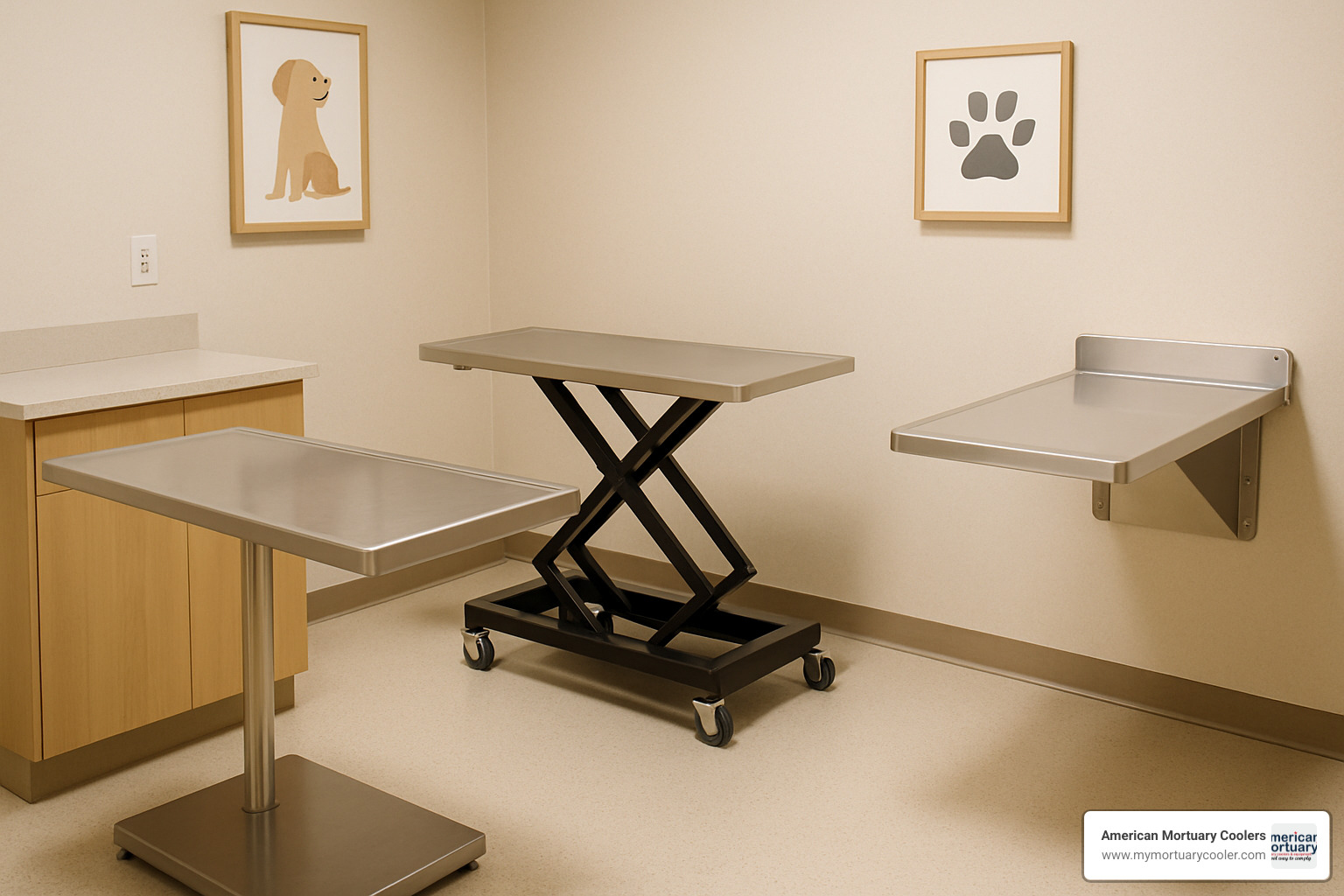
Walking into a veterinary clinic, you'll notice that not all vet exam tables are created equal. Just like pets come in all shapes and sizes, these essential workstations do too! Let's explore the main types you'll encounter and how each serves different practice needs.
Stationary & Wall-Mounted Vet Exam Tables
The reliable workhorses of many clinics, stationary and wall-mounted vet exam tables offer no-nonsense functionality that's always ready when you need it. These fixed-height surfaces shine in smaller practices where space is at a premium.
Stationary Wall Mounts make excellent use of limited square footage. Mounted directly to the wall, they free up valuable floor space while providing a stable examination surface. Many come with built-in storage drawers that keep commonly used instruments right at your fingertips.
Dr. Rebecca Lee from Sunshine Veterinary Clinic swears by hers: "Our wall-mounted table has been a workhorse for quick exams and minor procedures. The built-in drawer keeps our most frequently used instruments right where we need them."
At a standard height of 30-36 inches, these tables represent a middle-ground that works reasonably well for most staff. That said, they do require taller or shorter team members to adjust their posture rather than the other way around. The trade-off? They're typically more budget-friendly than their adjustable cousins.
Electric Lift Vet Exam Tables
If the stationary table is a reliable sedan, the electric lift vet exam table is the luxury SUV of veterinary equipment. These premium options prioritize staff comfort and patient experience above all else.
Using whisper-quiet electric motors, these tables glide smoothly between heights – typically from a low of 20 inches to a high of 39 inches. Lift Tables shine in busy practices where staff ergonomics matter.
"Investing in electric lift tables was the single best equipment decision we made when opening our practice," shares Dr. Thomas Greene. "Our staff reports significantly less back and neck pain, and the quiet operation helps keep our anxious patients calmer during exams."
Modern electric tables come with thoughtful safety features like obstacle detection that stops the table if it meets resistance while lowering. While they represent the highest initial investment, many practice owners find the reduced staff injury risk and longer career longevity make them worth every penny.
Hydraulic & Manual Vet Exam Tables
Looking for a middle ground between fixed and electric? Hydraulic and manual vet exam tables offer height adjustability without the premium price tag.
Most hydraulic models feature foot-pedal operation, leaving your hands free to steady nervous patients during adjustments. They don't require electrical outlets nearby, giving you flexibility in room layout and design.
"Our hydraulic tables have been reliable workhorses for over a decade," says Dr. Sarah Johnson of Westside Veterinary Hospital. "The foot pedal operation takes a bit more effort than electric models, but the tables have required minimal maintenance despite heavy daily use."
These tables do require occasional maintenance checks of hydraulic fluid levels, but with fewer electronic components, they often have fewer potential failure points. Some users note that raising larger patients requires more physical effort than with electric models – something to consider if you regularly see giant breed dogs.
Folding & Mobile Vet Exam Tables
For practices where every square inch counts or those providing care on the go, folding and mobile vet exam tables offer game-changing versatility.
Wall-mounted folding tables extend less than 5 inches from the wall when collapsed – perfect for cramped exam rooms or multi-purpose spaces. When needed, they fold down to provide a stable work surface, then tuck away neatly when you're done.
Some innovative models pull double-duty as both exam table and transport gurney. These combination units shine in emergency settings or facilities where patients frequently move between treatment areas.
Dr. Maria Sanchez, who runs a mobile practice, couldn't do without hers: "My folding table collapses to fit in my van but provides a stable, professional examination surface at client locations. It's transformed my mobile practice by giving me the same capabilities I'd have in a traditional clinic setting."
Multi-purpose options like the Co-Jack® table truly maximize versatility by functioning as a lift table, gurney, exam table, and surgery table all in one. For shelter medicine or house call veterinarians, these space-saving solutions make professional care possible anywhere.
Key Features & Materials to Compare in a Vet Exam Table
When shopping for a vet exam table, it's easy to get overwhelmed by all the options. But understanding what separates a good table from a great one will help you make a choice your staff (and their backs!) will thank you for years to come.
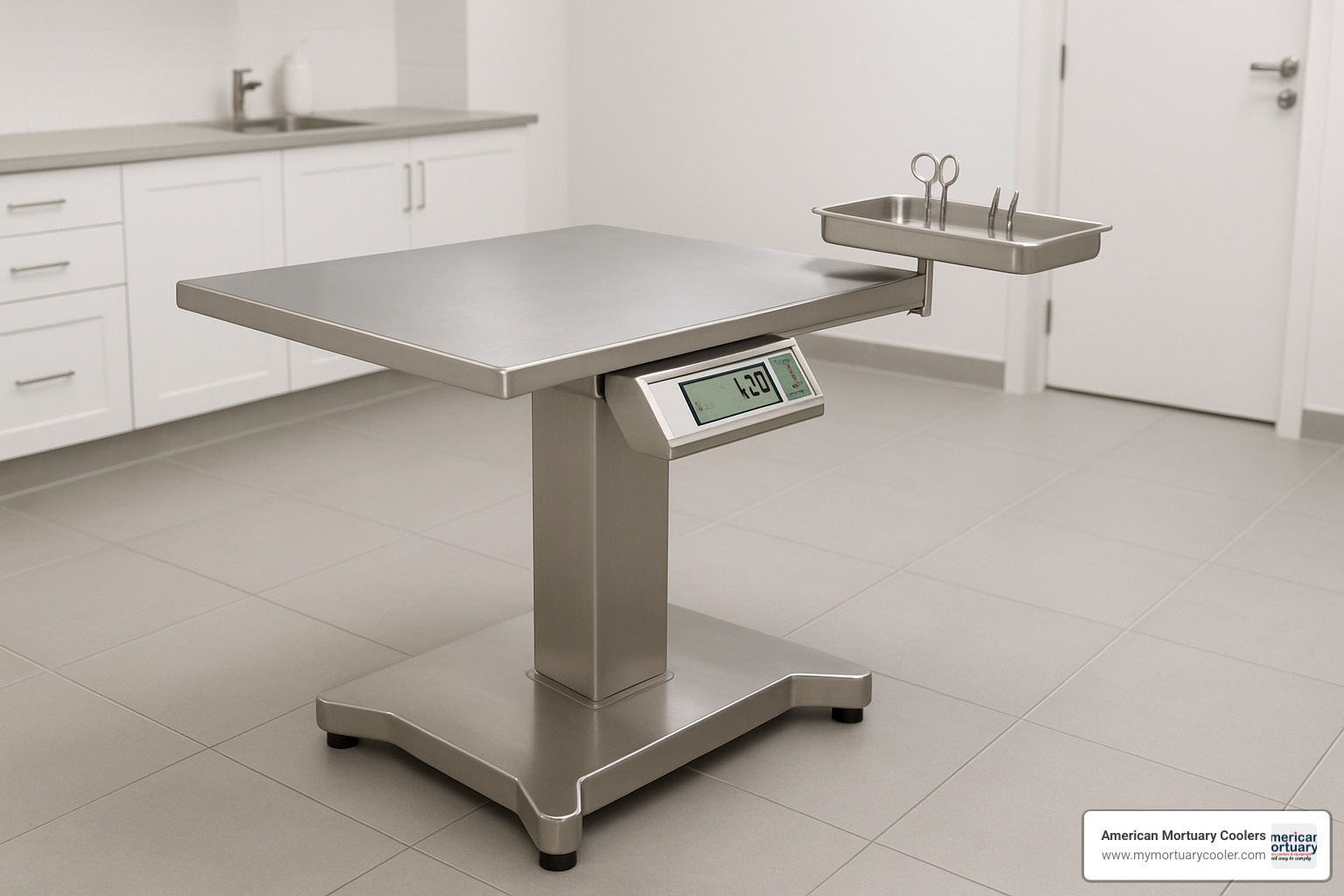
Let's talk materials first. You'll mainly encounter three options, each with their own personality:
| Material | Advantages | Considerations | Best For |
|---|---|---|---|
| 304 Stainless Steel | Exceptional durability, corrosion resistance, easy sanitization | Higher cost, can be cold for patients | High-volume practices, surgical procedures |
| Laminate | Cost-effective, warmer surface, lightweight | Less durable, may chip or peel over time | Budget-conscious clinics, exam-only tables |
| Phenolic | Chemical resistant, lightweight, durable | Limited color options, higher cost than laminate | Specialty practices with chemical exposure |
When it comes to lifting your furry patients, you've got three main systems to consider:
| Feature | Electric | Hydraulic | Manual |
|---|---|---|---|
| Operation | Push-button or foot pedal | Foot pump | Hand crank or lever |
| Noise Level | Very quiet | Moderate | Varies |
| Lift Smoothness | Excellent | Good | Variable |
| Price Range | $2,500-$6,500 | $1,800-$3,500 | $800-$1,800 |
| Power Source | Electrical outlet or battery | Self-contained hydraulic system | Mechanical |
| Maintenance | Electronic components may require service | Hydraulic fluid checks, occasional seal replacement | Minimal, mechanical parts only |
As highlighted in our article Prep Like a Pro with Stainless Steel Tables, medical-grade 304 stainless steel has become the industry gold standard. It stands up beautifully to the daily onslaught of disinfectants, bodily fluids, and the occasional nervous patient's claws.
Dr. Jennifer Williams puts it perfectly: "The initial investment in a quality stainless steel table pays dividends over time. Our oldest exam table is approaching 15 years of daily use and still looks and functions like new after proper maintenance."
Beyond just the shiny surface, you'll want to consider these practical features:
Height adjustability range makes a huge difference—look for tables offering 20" to 47" ranges to accommodate staff of different heights and make patient transfers easier. Your weight rating should comfortably exceed your largest anticipated patients (with room to spare). Don't overlook tie-down options—multiple secure attachment points are essential for those wiggly patients during procedures.
Smart storage matters too! Built-in drawers or shelving can transform your workflow by keeping essential tools right where you need them. If you perform x-rays, consider tables with radiolucent top options. And don't forget about those edge designs—raised edges help contain the inevitable messes, while rounded corners prevent staff injuries and make cleaning much easier.
Why Stainless Steel Reigns Supreme in Vet Exam Tables
There's a reason vet exam tables made of stainless steel dominate the industry—they're practically veterinary royalty!
The hygiene factor alone makes them worth their weight in gold. That non-porous surface prevents bacteria from hiding in tiny crevices, allowing for thorough disinfection between patients. Your furriest (and sometimes messiest) patients can't damage them easily either—stainless steel laughs in the face of scratches, dents and daily wear.
The chemical resistance is particularly impressive. Day after day of exposure to harsh disinfectants, medications, and all varieties of bodily fluids won't degrade a quality stainless steel surface. Many practices report their tables still going strong after 15+ years of service—now that's value for money!
Dr. Robert Chen, who's owned his practice for over two decades, shared his experience: "We've tried various table materials over the years. Nothing matches stainless steel for longevity. The tables we installed when we opened are still functioning perfectly despite thousands of patient examinations."
For the budget-conscious, many manufacturers offer stainless tops with powder-coated steel bases. This smart compromise maintains the hygienic benefits where they matter most while keeping costs reasonable.
Vet Exam Table Accessories That Boost Workflow
The right accessories can transform a good vet exam table into a fantastic workflow command center. These thoughtful additions can save steps, time, and staff energy throughout the day.
Integrated tool trays keep those frequently used instruments right at your fingertips during examinations. No more turning around or reaching across the room mid-procedure! Scale integration is another game-changer—getting accurate weights without transferring nervous patients to a separate scale reduces stress for everyone involved.
For practices that perform procedures at the table, anesthesia posts provide secure attachment points for equipment. LED lighting improves visibility for those detailed examinations (especially helpful for dermatology cases), while heated surfaces provide welcome comfort for older patients or during longer procedures.
"The integrated scale on our exam table has been a game-changer," says Dr. Lisa Peterson. "We get accurate weights on every patient without the stress of moving them to a separate scale, and the time savings adds up significantly over dozens of appointments."
When selecting accessories, think about your specific practice needs. A geriatric-focused practice might prioritize warming features, while a high-volume clinic might benefit most from smart storage solutions that keep supplies within arm's reach at all times.
The best vet exam table for your practice isn't just about having the shiniest equipment—it's about finding the perfect match for your workflow, patients, and team. The right table becomes almost invisible because it so perfectly supports what you need to do each day.
Ergonomics, Hygiene & Infection Control
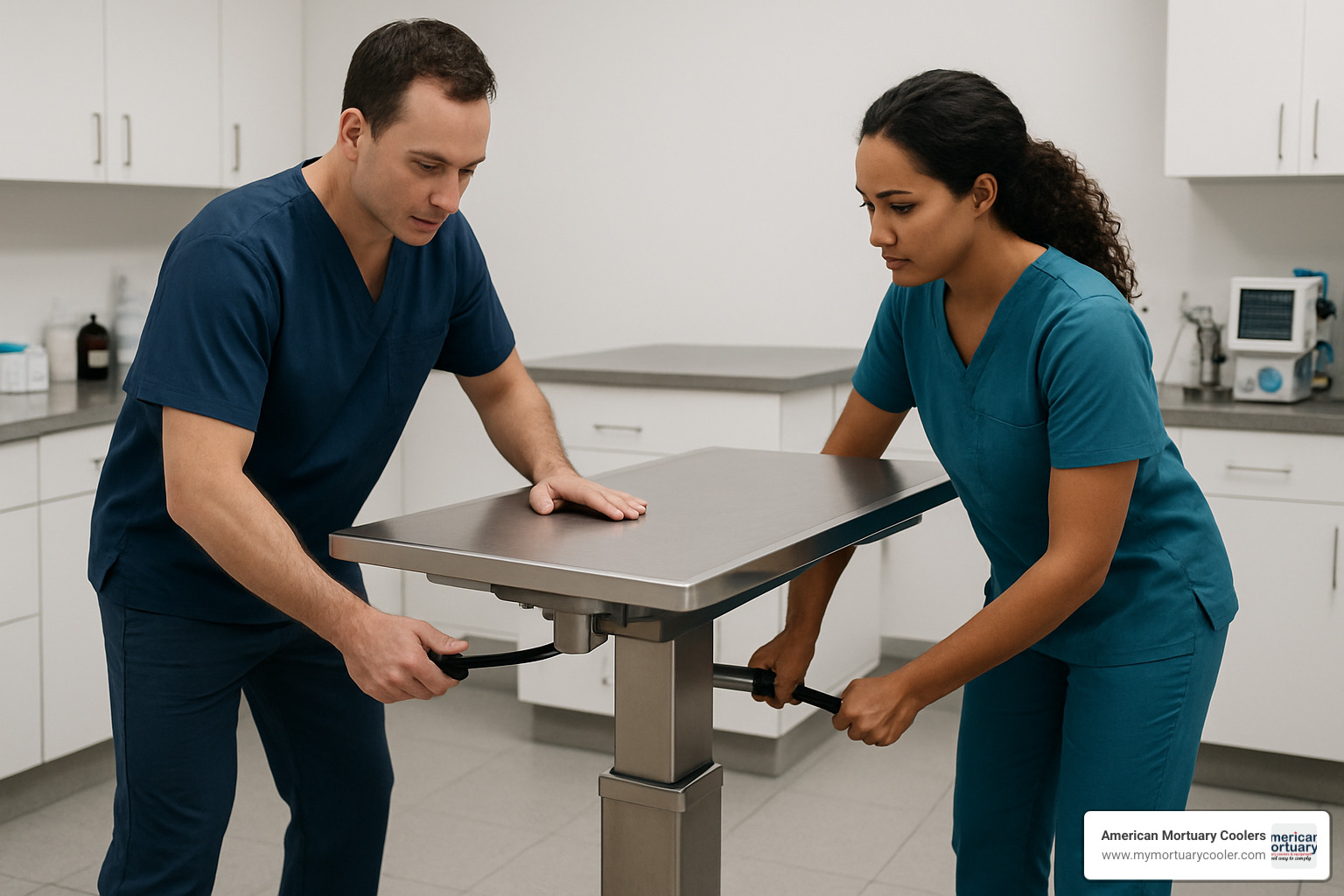
Let's talk about something that might not be the first thing on your mind when shopping for a vet exam table, but should definitely be near the top of your list: how it affects the health of both your staff and furry patients.
Ergonomics Considerations
Did you know that veterinary professionals have some of the highest rates of work-related injuries in healthcare? It's true! According to scientific research on ergonomic lift tables, height-adjustable tables can be a game-changer for your team's wellbeing.
"I used to go home with a backache every single day," shares Dr. Emily Carter, who specializes in veterinary occupational health. "The difference after we installed adjustable tables was like night and day. My team actually looks forward to exam days now instead of dreading them."
A good vet exam table with height adjustment can move from as low as 20 inches all the way up to 47 inches. This range means your 5'2" technician and 6'3" veterinarian can both work comfortably with the same equipment. Your back will thank you after a long day of seeing patients!
When checking out ergonomic features, pay attention to how the controls work. Foot pedals are fantastic since they keep your hands free for patient handling. The movement should be smooth and quiet – nothing worse than startling an already nervous pet with a loud mechanical noise. And of course, the table should remain rock-solid stable even when fully extended.
Hygiene & Infection Control
In veterinary medicine, you're potentially dealing with everything from routine check-ups to infectious diseases – sometimes back-to-back in the same exam room. Your vet exam table needs to stand up to serious cleaning protocols.
"Think about it this way," explains infection control specialist Dr. Michael Wong with a smile, "your exam table is basically ground zero for all sorts of interesting bodily fluids and potential pathogens. It needs to be your ally in the battle against cross-contamination, not your enemy."
The best tables feature seamless welded construction that eliminates those tiny crevices where bacteria love to hide. Some newer models even incorporate antimicrobial materials in their surfaces – a nice bonus, though never a replacement for thorough cleaning.
Fluid management is another crucial feature. Those raised edges aren't just for show – they help contain messes that would otherwise end up on your floor (or worse, your shoes). Some tables include clever drainage systems that direct fluids away from your work area, making cleanup much more manageable.
Designing for Easy Cleaning
Have you ever tried cleaning something with lots of nooks and crannies? Frustrating, right? That's why the best vet exam tables are designed with cleaning in mind from the ground up.
"When I'm shopping for a new table, the first thing I do is get down and look underneath it," laughs practice manager Stephanie Rodriguez. "If I can see places where hair and grime could build up beyond my reach, that's an automatic no."
Look for open frame designs that minimize hidden spaces. Removable mats are a huge plus, allowing you to thoroughly clean underneath. Rounded corners not only prevent injury but also make wiping down surfaces much easier. And of course, materials matter – your table should withstand years of exposure to disinfectants without showing wear.
For specialty practices dealing with infectious cases, consider tables with completely sealed components that can handle a thorough washdown. These might cost more upfront, but the added protection is invaluable.
Noise & Stress Reduction for Patients
We've all seen it – that moment when a pet freezes in fear at the sound of equipment moving. Modern vet exam table design increasingly focuses on creating a less stressful experience for our four-legged friends.
Dr. Karen Nelson, who practices Fear Free℠ techniques, puts it perfectly: "The exam table sets the tone for the entire visit. A cold, noisy metal surface immediately puts patients on edge. But a quiet table with a comfortable surface? That can make all the difference between a straightforward exam and a wrestling match."
Electric lift systems with quiet motors prevent startling jumpy patients. Non-slip mats or padded surfaces give pets secure footing and comfort. Some practices are even adding warming features to their tables – particularly helpful for older patients or those undergoing longer procedures.
"We added warming pads to our exam tables last year," shares Dr. Nelson. "Our senior patients especially seem to appreciate it. We've noticed they're noticeably calmer during exams when they're warm and comfortable."
By prioritizing ergonomics and thoughtful design features, your vet exam table becomes more than just a piece of equipment – it becomes an investment in the health and comfort of everyone who uses it, both two-legged and four-legged.
Choosing, Maintaining & Budgeting for Your Vet Exam Table
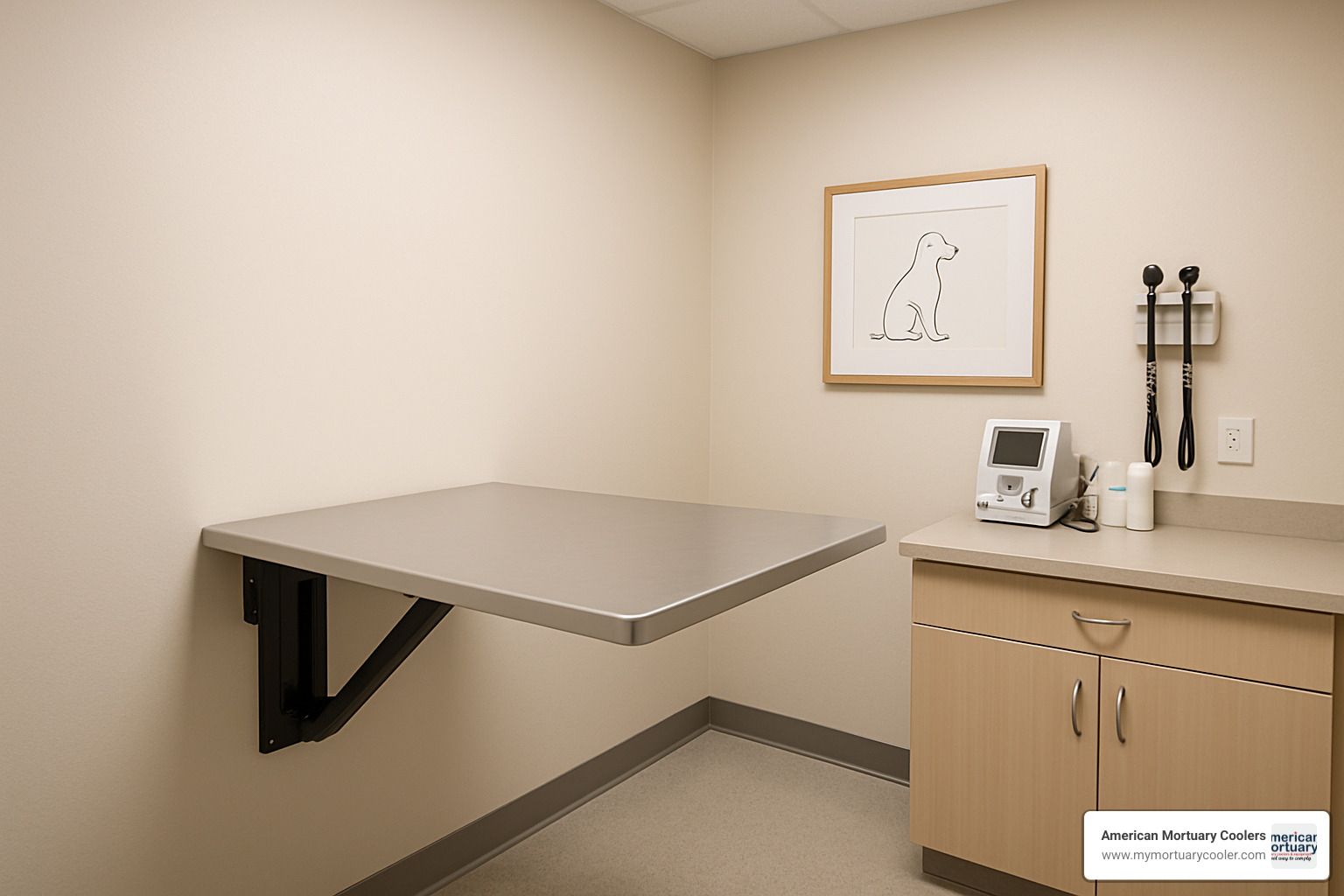
Finding that perfect vet exam table for your practice is a bit like choosing a good partner – it needs to match your specific needs, support you reliably, and hopefully stick around for the long haul. Let's walk through how to make this important decision without breaking the bank or ending up with a table that doesn't quite fit your workflow.
Determining the Best Fit for Your Workflow
Think about your typical day at the clinic. Are you primarily doing quick wellness checks, or do you perform lots of dental procedures and minor surgeries? The procedures you commonly perform should guide your table choice.
Dr. James Wilson puts it perfectly: "Map out your typical appointment flow and identify any bottlenecks or ergonomic challenges. The right exam table can solve many of these issues if you select features that address your specific pain points."
If your team includes both a 6'4" veterinarian and a 5'2" vet tech, you'll definitely want to consider height-adjustable options. I've seen practices where shorter staff members were literally standing on step stools to examine patients – not exactly the picture of efficiency or safety!
Your patient demographics matter tremendously too. A practice specializing in Maine Coons and Great Danes needs substantially different weight capacities than one focusing on pocket pets and cats. And don't forget about your space constraints – those gorgeous expansive tables look amazing in the catalog but might overwhelm your cozy exam rooms. Wall-mounted folding tables can be lifesavers in tight spaces, giving you back precious square footage when not in use.
Many practices find success with a mixed approach – perhaps a fixed-height table in standard exam rooms and an electric lift table in a dedicated procedure room. This balanced investment targets your resources where they'll make the biggest difference.
Maintenance & Durability Checklist
Even the best vet exam table needs some TLC to stay in top shape. Think of it like caring for your car – regular maintenance prevents costly breakdowns.
Daily attention is your first line of defense. Beyond the obvious cleaning between patients (a must for infection control!), take a moment to check that all moving parts operate smoothly. A quick wipe-down of lift mechanisms prevents hair buildup that can eventually cause problems.
Equipment specialist Thomas Rodriguez emphasizes, "Preventative maintenance is far less expensive than emergency repairs. Simple monthly checks can identify potential issues before they lead to table failure during a critical procedure." That's wisdom worth heeding – nothing disrupts your day quite like a table that won't adjust during a procedure.
Monthly maintenance should include inspecting hydraulic systems for leaks, checking electrical connections, and lubricating moving parts according to the manufacturer's guidance. I've seen practices create simple maintenance calendars to make sure these tasks don't fall through the cracks.
Once a year, consider having a professional inspection of lift mechanisms, especially for electric tables. This is also a good time to evaluate the table surface for damage that might compromise infection control.
Most manufacturers provide detailed maintenance guidelines specific to their models. Following these recommendations not only extends your table's life but typically keeps your warranty valid too. When you're investing thousands in quality equipment, that warranty protection matters.
Budget Considerations & Price Tiers
Let's talk money – because vet exam tables come in a wide range of price points. Think of it as similar to buying a car – you can get a basic model that gets you from A to B, or you can invest in something with all the bells and whistles.
At the economy tier ($800-$1,500), you'll find fixed-height tables and basic wall-mounted options. These are perfectly functional, especially for straightforward exams, but may lack ergonomic benefits and durability features of higher-end models.
In the mid-range ($1,500-$3,500), manual hydraulic lift tables offer height adjustability without breaking the bank. The stainless steel quality tends to be better here, with more thoughtful storage options and improved warranty coverage.
The premium category ($3,500-$6,500+) brings you electric lift tables, often with programmable height presets, integrated scales, and customizable configurations. These tables feel like a splurge initially but can pay dividends through staff injury prevention and workflow efficiency.
Dr. Rebecca Chen recently opened a new practice and shared her smart approach: "We prioritized one premium electric table for our dental suite where procedures take longer and ergonomics are critical. For standard exam rooms, we selected mid-range hydraulic tables that still offer height adjustment but at a more budget-friendly price point."
Remember to factor in not just the sticker price, but also installation costs, warranty options, and expected service life. Many suppliers offer financing that lets you enjoy a better table while spreading payments over time. This approach can make premium tables more accessible while giving you immediate ergonomic benefits.
For more detailed comparison information, our More info about comparison guide provides additional insights to help you evaluate different options.
At American Mortuary Coolers, we understand that choosing the right equipment is a significant decision. While we specialize in mortuary equipment, we apply the same principles of durability, functionality, and value to all our recommendations, including vet exam tables. And with our direct delivery across all 48 contiguous states, getting your new table is hassle-free, regardless of your location.
Frequently Asked Questions about Vet Exam Tables
How do I decide between electric and hydraulic vet exam tables?
Choosing between electric and hydraulic vet exam tables is one of the most common dilemmas practice owners face. I've helped hundreds of clinics make this decision, and it really comes down to your specific needs.
Electric tables offer that wonderful push-button convenience – just press and watch the table smoothly rise to exactly the height you need. They're whisper-quiet, which is a huge plus for nervous pets (especially those skittish cats!). The downside? They'll typically cost you 30-50% more than hydraulic models, and you'll need to have electrical outlets positioned near your table location.
Dr. Michael Roberts from Feline Friends Veterinary shares: "We invested in electric tables throughout our cat-only practice, and it's been worth every penny. The silent operation means our feline patients stay much calmer during exams."
Hydraulic tables, meanwhile, offer a fantastic middle ground. You'll get the height adjustability that saves your back (just pump the foot pedal to raise it), but at a more budget-friendly price point. They don't require electricity, giving you more placement flexibility, and they generally have fewer components that might need repair down the road. The trade-off is the slight noise and physical effort required to pump them up.
For most general practices, hydraulic tables provide that sweet spot of functionality and value – but if noise sensitivity or ease of operation is paramount, electric might be your better bet.
What optional features give the best ROI for small clinics?
When you're running a small clinic with budget constraints, every dollar needs to work hard for you. I've found these vet exam table features consistently deliver the biggest bang for your buck:
Height adjustability is absolutely worth the investment, even if you go with a basic hydraulic model. Your staff's backs will thank you, and you'll likely see fewer sick days and longer careers from your team. The ergonomic benefits alone justify the additional cost over fixed-height tables.
Integrated scales are pure workflow magic. Dr. Sarah Johnson puts it perfectly: "Our integrated scale paid for itself within months. We save at least two minutes per appointment by not having to move patients to a separate scale, which adds up to an extra appointment slot each day." That's real revenue impact from a single feature!
Quality stainless surfaces might make you wince at the initial price tag, but they'll outlast laminate alternatives by years while requiring less maintenance. The infection control benefits and durability make this a no-brainer upgrade.
Built-in storage keeps your frequently used supplies right at your fingertips, eliminating those constant trips across the exam room. This seemingly small convenience adds up to significant time savings across dozens of daily appointments.
Removable, washable mats improve patient comfort while allowing you to maintain impeccable hygiene standards. They're relatively inexpensive but contribute greatly to both the patient experience and infection control protocols.
For small practices, I generally recommend prioritizing these practical features while skipping bells and whistles like programmable height presets or specialized positioning capabilities – at least until your budget has more breathing room.
Are there specific safety standards my vet exam table must meet?
Safety should never be an afterthought when selecting a vet exam table. While veterinary equipment isn't regulated quite as stringently as human medical equipment, there are still important standards to look for that protect both your team and patients.
First, check for UL or CE certification on any table with electrical components. These marks indicate the electrical systems have been tested for safety and meet recognized standards. This is particularly important for electric lift tables that will be used daily for years.
Weight capacity certification is absolutely crucial – the manufacturer should clearly state how much weight the table has been tested to support. Always build in a safety margin beyond your largest expected patients. A table rated for 500 pounds will maintain its stability and performance much longer than one operating near its maximum capacity.
Look for pinch-point protection features, especially in adjustable tables. Quality manufacturers build in safety mechanisms that prevent injury during height adjustments – particularly important in busy clinics where distractions are common.
Surface materials should meet medical-grade standards for chemical resistance, ensuring they won't degrade with repeated disinfection. This protects both the longevity of your investment and the safety of your patients.
"Don't hesitate to request detailed safety information from manufacturers," advises veterinary architect Emma Rodriguez. "Quality manufacturers will readily provide this documentation and can explain the safety features built into their designs."
At American Mortuary Coolers, we apply the same rigorous safety standards to our veterinary equipment that we use in our medical-grade mortuary products. Safety isn't just a checkbox – it's fundamental to creating equipment that serves you reliably for years to come.
Conclusion
Selecting the right vet exam table is more than just buying a piece of equipment – it's making an investment in your practice's heartbeat. After all, this is where the magic happens: where diagnoses are made, treatments are performed, and bonds with patients are strengthened.
Throughout this guide, we've walked through everything you need to know to make this important decision with confidence. Let's take a moment to reflect on the key points that will help you choose wisely.
Your table should match your unique workflow. Think about the patients you see most often, the procedures you perform daily, and the space you have available. A busy practice seeing large dogs has different needs than a cat-only clinic or mobile veterinarian. The perfect table for your colleague might be completely wrong for you!
Ergonomics matter deeply for your team's wellbeing. I've spoken with countless veterinarians who wished they'd prioritized height-adjustable tables earlier in their careers. Dr. Sarah Thompson puts it perfectly: "My only regret is waiting ten years to invest in proper lift tables. My back would have thanked me sooner."
When it comes to materials, stainless steel truly shines. Yes, it costs more upfront, but the durability, cleanability, and longevity make it the smart choice for most practices. Many veterinarians report their stainless tables looking almost new after a decade of daily use – that's value you can count on.
Maintenance isn't optional – it's essential. Simple daily cleaning, monthly checks, and annual professional inspections will keep your table performing beautifully for years. Think of it as preventive medicine for your equipment!
Finally, think ahead to where your practice is going, not just where it is today. The table you choose should grow with you, accommodating new services or patient demographics as your practice evolves.
At American Mortuary Coolers, we understand the importance of durable, functional equipment in healthcare settings. While our Tennessee-based company specializes in mortuary coolers and related equipment for the funeral industry, we apply the same principles of quality construction and attention to detail that are essential in veterinary equipment.
Our expertise in stainless steel fabrication and custom solutions gives us unique insight into the features that contribute to equipment longevity and performance. We deliver our custom-built solutions directly across the contiguous 48 states, ensuring that quality equipment reaches facilities nationwide.
For those interested in exploring more specialized equipment options, our Detailed guide to MOBI Medical Supply equipment provides additional information on medical-grade equipment solutions.
The perfect vet exam table becomes almost invisible in your workflow – supporting your team so seamlessly that you hardly notice it's there. By thoughtfully evaluating your needs and choosing features that truly matter for your practice, you'll find a table that serves as the reliable foundation for exceptional patient care for years to come.
